
Innovation is part of the human growth process. Without innovation, humans would be difficult to develop. One of them is on the roof. The roof innovation allows us to get the safety and comfort.
|
Home Improvement |

Innovation is part of the human growth process. Without innovation, humans would be difficult to develop. One of them is on the roof. The roof innovation allows us to get the safety and comfort.

 Carport design consists of parts of floors, walls, and roof retaining structures and also roofing frame. How is the structure of the roof?
Carport design consists of parts of floors, walls, and roof retaining structures and also roofing frame. How is the structure of the roof?
Retaining structure of carport roof frame can be categorized into three types:
1. Stands alone structure: stand-alone structure can be supported on four main points, or it could be just the two main points by using a cantilever system. The columns can be selected from the columns supporting concrete, wood, iron, steel, or some combination of these materials. The outer display columns can be selected in accordance with the carport design concept.
2. Sticking mostly structure: carport which is very close to the main building will have an advantage. Roof frame can be made with a stick house. This method makes more efficient carport construction costs. Only with two supporting points, carport is quite sturdy. In order to look attractive, you should use a carport construction systems and materials in line with the construction of houses and the main facade.
3. Hanging structure: a hanging structure is cantilevered structure with iron sling or steel sling. This system allows the roof to hang freely without the need for additional columns. Required materials for lightweight roof frame and cover. This structure typically uses type of flat roof.
 Some things you need to consider about the wiring at home.
Some things you need to consider about the wiring at home.
Currently, electricity cannot be separated from any activity in the house. So important role, but there are still a lot of users are still lay to the things that should be considered. Electric current cannot be taken lightly. It is not only a matter of electrical input, but the path to the output. In other words, you need to recognize more details about the specification of materials, cable conductivity, and the influence of flow to weather changes.
Check out 5 things you must consider when creating a new electricity grid.
1. Outlet
Note the ideal distance from the outlet point of the floor is between 1-2 meters. Be sure not to overload, one outlet ideally can divided with a T-plug to 4 branching.
2. Cable
Do not just buy the cable, adjust the power delivered. Electrical wiring with copper conductor and PVC insulated permanently installed in your home should be a minimum size of 2.5 mm2, regardless of the amount of electrical power should only be installed and powered up 10A. Use a measuring cable 4mm2 if electric current is between 10A – 16A.
3. Grounding
Grounding on electrical installations are as preventing contact between human with an exposed electrical voltage due to insulation failure. Grounding installed in your house two kinds of electrical installations for home and installation of lightning rods. Two of these grounding system installation and had to be separated is at least 10m. Grounding connections for homes electrical installations installed in kWh meter.
4. Rain and Leaks
Better not make improvements where they have heavy rain or roof leaks, it is closely related to the water as a conductor of electricity, so it is often a short circuit occurs or surge. Also, do not perform repair electrical installations where they have occurred thunder and lightning that were darting.
5. Periodic checks
Perform electrical installation periodically checks using the services of a trusted officer or agency. If in the future there are installation problems, you can call them back to make repairs, or make additions to existing installations.